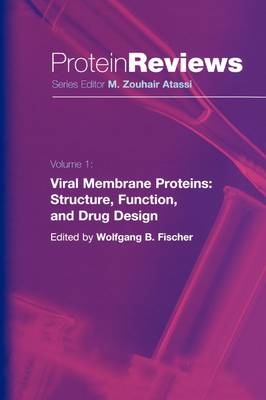(To see other currencies, click on price)
MORE ABOUT THIS BOOK
Main description:
In Viral Membrane Proteins: Structure, Function, and Drug Design, Wolfgang Fischer summarizes the current structural and functional knowledge of membrane proteins encoded by viruses. In addition, contributors to the book address questions about proteins as potential drug targets. The range of information covered includes signal proteins, ion channels, and fusion proteins.
This book has a place in the libraries of researchers and scientists in a wide array of fields, including protein chemistry, molecular biophysics, pharmaceutical science and research, bioanotechnology, molecular biology, and biochemistry.
Contents:
Part I. Membrane Proteins from Plant Viruses 1. Membrane Proteins in Plant Viruses Michael J. Adams and John F. Antoniw 1. Introduction 2. Survey of Transmembrane Proteins in Plant Viruses 2.1. The Database 2.2. Software 3. Cell-To-Cell Movement Proteins 3.1. The '30k" Superfamily 3.2. Triple Gene Block 3.3. Carmovirus-Like 3.4. Other Movement Proteins 3.5. General Comments 4. Replication Proteins 5. Proteins Involved in Transmission by Vectors 5.1. Insect Transmission 5.2. Fungus Transmission 6. Other Membrane Proteins 7. Conclusions Acknowledgments References 2. Structure and Function of a Viral Encoded K Channel Anna Moroni, James Van Etten, and Gerhard Thiel 1. Introduction 2. K Channels are Highly Conserved Proteins with Important Physiological Functions 3. Structural Aspects of Viral K Channel Proteins as Compared to those from Other Sources 4. The Short N-Terminus is Important for Kcv Function 5. Functional Properties of Kcv Conductance in Heterologous Expression Systems 6. Kcv is a K Selective Channel 7. Kcv has some Voltage Dependency 8. Kcv has Distinct Sensitivity to K Channel Blockers 9. Ion Channel Function in Viral Replication v Vimp-FM.qxd 17/07/2004 03:07 PM Page v 10. Kcv is Important for Viral Replication 11. Evolutionary Aspects of the Kcv Gene Acknowledgments References Part II. Fusion Proteins 3. HIV gp41: A Viral Membrane Fusion Machine Sergio G. Peisajovich and Yechiel Shai 1. Introduction 2. HIV Envelope Native Conformation 3. Receptor-Induced Conformational Changes 3.1. CD4 Interaction 3.2. Co-Receptor Interaction 4. The Actual Membrane Fusion Step 4.1. TheRole of the N-Terminal Fusion Domain 4.2. The Role of the C-Terminal Fusion Domain 5. HIV Entry Inhibitors 5.1. CD4-Binding Inhibitors 5.2. Co-Receptor Binding Inhibitors 5.3. Improving the Activity of Inhibitors that Block Conformational Changes 6. Final Remarks Acknowledgment References 4. Diversity of Coronavirus Spikes: Relationship to Pathogen Entry and Dissemination Edward B. Thorp and Thomas M. Gallagher 1. Introduction 2. S Functions during Coronavirus Entry 3. S Functions during Dissemination of Coronavirus Infections 4. S Polymorphisms Affect Coronavirus Pathogenesis 5. Applications to the SARS Coronavirus 6. Relevance to Antiviral Drug Developments References 5. Aspects of the Fusogenic Activity of Influenza Hemagglutinin Peptides by Molecular Dynamics Simulations L. Vaccaro, K. Cross, S.A. Wharton, J.J. Skehel, and F. Fraternali 1. Introduction 2. Methods 3. Results 3.1. Comparison with Experimental Structures 3.2. Membrane Anchoring vi Contents Vimp-FM.qxd 17/07/2004 03:07 PM Page vi Contents vii 4. Conclusions Acknowledgment References Part III. Viral Ion Channels/Viroporins 6. Viral Proteins that Enhance Membrane Permeability Maria Eugenia Gonzalez and Luis Carrasco 1. Introduction 2. Measuring Alterations in Membrane Permeability 2.1. The Hygromycin B Test 2.2. Entry of Macromolecules into Virus-Infected Cells 2.3. Other Assays to Test the Entry or Exit of Macromolecules from Virus-Infected Cells 2.3.1. Entry or Exit of Radioactive Molecules 2.3.2. Entry of ONPG and Dyes 2.3.3. Entry of Propidium Iodide 2.3.4. Release of Cellular Enzymes to Culture Medium 3. Viral Proteins that Modify
PRODUCT DETAILS
Publisher: Springer (Springer-Verlag New York Inc.)
Publication date: December, 2010
Pages: 312
Weight: 480g
Availability: Available
Subcategories: Biochemistry, Immunology, Microbiology, Pharmacology
From the same series


























